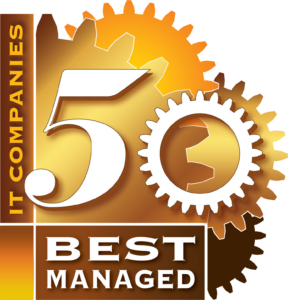
What is Digital Transformation for Small and Mid-Size Companies?
What is Digital Transformation for Small and Mid-Size Companies?
Digital transformation is an important concept for new and existing companies to understand.
As organizations grow and mature, they tend to run into problems with their technology. They might have inefficient workflows or old software that doesn’t really talk to each other.
These companies need to find a way to streamline their operations, data, and workflows. And that’s where digital transformation becomes so important.
Where Does Digital Transformation Start?
We start by thinking about how to leverage technology effectively in your organization with the tools that are available. When we think about an IT roadmap, many people just aren’t aware of what’s possible, and what’s out there, and what’s available to them.
We always start by finding out what the current state of an organization’s IT infrastructure is. We set out to answer questions like:
- How do the current systems and processes work?
- What technology is already there?
- What are some of the gaps and challenges?
- Are there business problems related to these challenges?
Once we have those answers, we can look to the future and say, okay, here’s what’s available from a technology perspective. This is what is possible. And how do we get to that future state?
We make a plan on how we’re going to get there. Next, what needs to be put in place? Sometimes it’s different equipment or technology. That could include different software, different hardware, or other things that need to be set up.
Dependence on Technology
Another concern when you’re developing an IT roadmap for your organization is that you often become more dependent on technology. In other words, maybe you’re not really leveraging technology today, or you’re leveraging it in a limited fashion.
When you look at how you can leverage technology and you implement new technology in your company, and you start to really use it, you become very dependent on it. And that tends to change most people’s perspective on their technology because some of the things that weren’t very important before are now mission-critical to the organization.
In years past, if your system went down for a little while, for example, it wasn’t a big deal. But today, your entire operation might be dependent on technology to stay up and running. Your plant floor, for example, or your ERP system, or your CRM system is being used all day every day by lots of people within your organization. It is absolutely critical that that stays up and running. And that tends to change the perception that people have of technology.
Lots of organizations reach an inflection point where they say that they’ll have to focus on how they manage technology. They need to find a better way to do that. And that’s where CopperTree can come in.
When we ask business leaders what they want, they want everything to just work. They want to sleep at night knowing that their risks are managed, and they want to know that they have the right tools in place. And our process is designed to get you there.
Digital Transformation in the Construction Industry
We had great success recently when we used the IT roadmap process with a construction company client. When we first brought them on, they were growing, but they had been around for quite a long time. They still had a lot of very manual processes in place.
Everything was written down on paper, and all of that manual data entry increased the risk of mistakes. They would bring that paper back to the office, and somebody at the office would manually enter the information off of the paper into the computer system.
It was a lot of work and took a significant amount of time. The time between the company performing the service and actually invoicing it once it got through their system was not helping the business.
We looked at how they were doing things and knew that we could streamline the processes and make them better. And so we went through the IT roadmap process.
We looked at their current state, did a needs analysis, and looked at the gaps and the business processes. Then we looked at the software that was available and how they could leverage it within their company.
Automating Processes with Technology
In the end, they moved to a software tool that helped them automate a lot of these manual processes. Now, when somebody is out in the field, they aren’t writing things down on a piece of paper. They’re putting the information into a tablet. The data is live and it’s going back to the office where they can monitor it. They can track where the project is from the office. And they have all the information they need to be able to do the invoicing.

Most importantly, there’s no second or third manual data entry happening. It’s all automated.
Big picture, the ROI on this project was very short. The client was able to recoup their costs within a matter of months. But there was an even bigger benefit. Before they put this system in place, they had maxed out how fast they could grow. The processes they had in place were limiting them. And with the new systems in place, they’re looking at growing their organization significantly in the next couple of years. And that’s really what digital transformation can do for a business.



